#Published 108
Explore tagged Tumblr posts
Text
extremely funny coincidences with time travel au: final chapter count's on the darn fic now. of course it ends in 14.
12 notes
·
View notes
Text

#Batman #108 (2021) Stanley #Artgerm Lau Card Stock Variant, #JorgeJiménez & #RicardoLopezOrtiz Pencils, #JamesTynionIV Story, #MiracleMolly (First Full Appearance) Batman goes undercover to infiltrate the transhumanist gang known as the Unsanity Collective and learn more about their sudden appearance in Gotham. https://rarecomicbooks.fashionablewebs.com/Batman%202016.html#Batman108 @rarecomicbooks Website Link In Bio Page If Applicable. SAVE ON SHIPPING COST - NOW AVAILABLE FOR LOCAL PICK UP IN DELTONA, FLORIDA #KeyComicBooks #DCComics #DCU #DCUniverse #KeyIssue #KeyComics #FirstAppearances #1stAppearance
#Batman#108 (2021) Variant Stanley Artgerm Lau Card Stock Cover#Jorge Jiménez & Ricardo Lopez Ortiz Pencils#James Tynion IV Story#Miracle Molly (First Full Appearance)#Rare Comic Books#Key Comic Books#DC Comics#DCU#DC#Marvel Comics#MCU#Marvel#Marvel Universe#DC Universe#Dynamite Entertainment#Dark Horse Comic Books#Boom#IDW Publishing#Image Comics#Now Comics#Key Comics#Rare Comics#Vintage Comics
0 notes
Text
"But this characterization confuses IA’s practices with traditional library lending of print books. IA does not perform the traditional functions of a library; it prepares derivatives of Publishers’ Works and delivers those derivatives to its users in full. That Section 108 allows libraries to make a small number of copies for preservation and replacement purposes does not mean that IA can prepare and distribute derivative works en masse and assert that it is simply performing the traditional functions of a library." Hachette Book Group, Inc. v. Internet Archive, No. 23-1260, at 31 (2nd Cir. Sept. 4, 2024).
#hatchette v internet archive#internet archive#live blogging appellate decisions#and yes I'm including the correct bluebook citation just to be pedantic
308 notes
·
View notes
Text
The Bakunawa [Filipino mythology]!
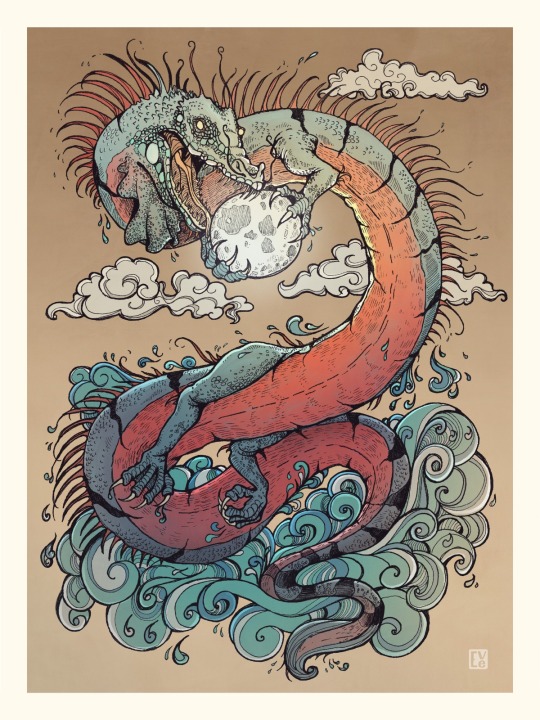
Whether it is said to live in the sky, the ocean or deep in the underworld, the Bakunawa (also Baconaua or Bacunawa) is one of the most important spirits in the religion of the indigenous people from the Philippines. A creature of truly unimaginable proportions, the Bakunawa is so large that eclipses were claimed to have been caused by the great serpent devouring the moon.
This monster was also associated with natural disasters: it causes typhoons by blowing air through its cavernous maw, and creates earthquakes by shaking its titanic tail. It was for this reason that Visayan people would make noises (by shouting and beating empty cans) during natural disasters, to scare the snake and make it leave.
Among the Ilonggos people, the Bakunawa resembles a shark with a bright red tongue and whiskers around its mouth. It is equipped with ash-gray wings to soar through the heavens, and a series of smaller wings sprout from its sides. Fitting with its aquatic characteristics, the Bakunawa lives deep in the ocean.
Alternatively, the Visayan people describe the creature as a gargantuan dragon-like snake with a characteristic looped tail. This seems to be the most common depiction today. Belief in the Bakunawa is derived from Hinduism, and the name (which means ‘bent serpent’) is likely derived from Sanskrit.
In a Cebuano story, there were once seven moons in the sky. The Bakunawa, wanting to possess them, started devouring them one by one. After eating six moons, the god Bathala stopped him. Interestingly, an alternate Visayan story portrays the Bakunawa as a playful (but ultimately not malicious) animal enticed by the brightly shining moon. Believing it to be a ball, the gigantic snake played with the moon and swallowed it.
Yet another version, in Karay-a belief, has the Bakunawa be a species of monsters rather than a single individual. Some of them have a thin or transparent stomach – if these creatures eat the moon, a partial eclipse follows. Others have a thick-walled stomach, and they can cause a total eclipse.
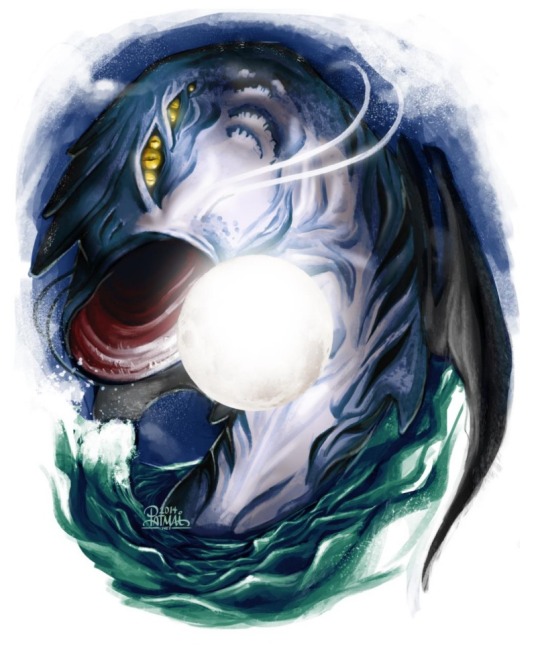
Whether it is a shark or a snake differs between versions and regions, but the Bakunawa always retains its main defining trait of devouring the moon.
The Bakunawa is still alive today and its movements still influence our world: the supposed movement of the beast (on a 16-point chart) is the basis for the Visayan calendar. For example, at the start of each year, the creature’s head points to the north with its tail pointing to the south. This indigenous calendar was actually censored because of Christianity for a time.
As recent as the late 20th century, a belief persists that the orientation of a newly built house has to align with the creature. For example, the staircase has to face the Bakunawa’s back, or else the evil aura of the monster will enter the house and kill the homeowner’s family. For this purpose, people would consult a ritualist or ritual manual to determine the snake’s current position during construction.
Sources:
Mojares, R. B., 2012, “Dakbayan”, A Cultural History of Space in a Visayan City, Philippine Quarterly of Culture and Society, 40(3/4), pp. 170-186.
McCoy, A. W., 1982, Baylan: Animist religion and Philippine peasant ideology, Philippine Quarterly of Culture and Society, 10(3), pp. 141-194.
Gaverza, J. K. M., 2014, The Myths of the Philipines, An Undergraduate Thesis Submitted to the College of Social Science and Philosophy Diliman, Quezon City, as Partial Fulfillment of the Requirements for the Degree of B. A. Linguistics, p. 28-29, 108-110, 177 pp.
Ramos, M. D., 1990, The Creatures of Philippine Lower Mythology, Phoenix Publishing House, p. 35-40, 424 pp.
(Image source 1: Eve Berthelette)
(Image source 2: Patricia de Vera)
54 notes
·
View notes
Text
Industrial Steel & Glass Set

Published: 1-30-2024 | Updated: 9-8-2024 SUMMARY A 20-piece steel and glass set for industrial builds. Mix and match as needed with move objects on/off and grid on/off cheats. Objects are 1-tile, visible from hood view, and need to be combined with other objects if you want to prevent rain, snow, and sims from intersecting them.

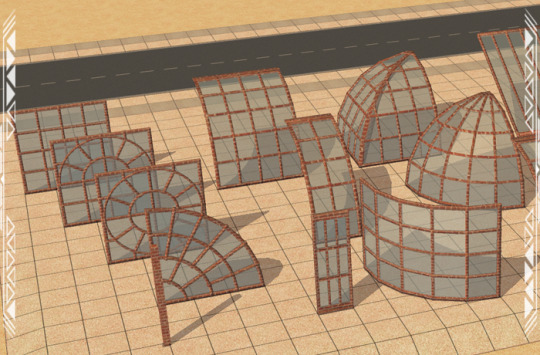

DETAILS Requires all EPs/SPs. §300 | Build > Architecture You need the BBNiche1Master (Buggybooz, 2012), Roofing Repository, and Glass Repository – available in the Repository Pack (Simmons, 2023). Objects are meant to be used with 1-story walls (or higher). **I decimated the frames a bit to lower poly count. Please forgive minor imperfections – but if you notice serious holes/errors in the meshes, let me know.

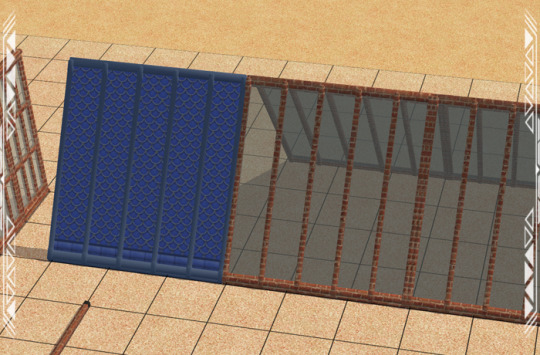
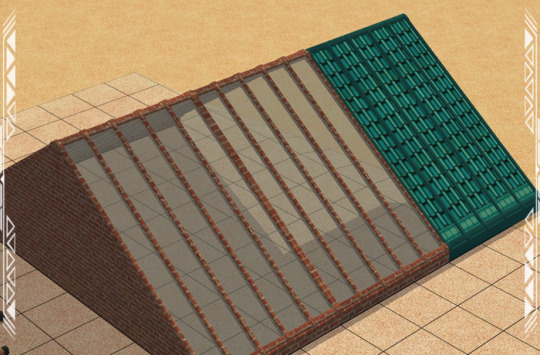
ITEMS Base 001 (724 poly) Base 001 Corner (878 poly) Base 002 (938 poly) Base 003 (1178 poly) Corner Niche (20 poly) Roof 001 (902 poly) Roof 001 Corner (1038 poly) Roof 001 (Long) (828 poly) Roof 002 (841 poly) Roof 002 Corner (967 poly) Roof 003-A (704 poly) Roof 003-B (706 poly) Roof 003-C (704 poly) Roof 003-D (706 poly) Roof 003 Corner (870 poly) Roof Niche 001 (33 poly) Roof Niche 002 (33 poly) Wall Deco 001 (108 poly) Wall Deco 002 (216 poly) Window (Deco) (572 poly)
DOWNLOAD (choose one) from SFS | from MEGA *collection file included
GRAPHIC GLASS ADD-ONS from SFS | from MEGA *separate collection file for add-ons included
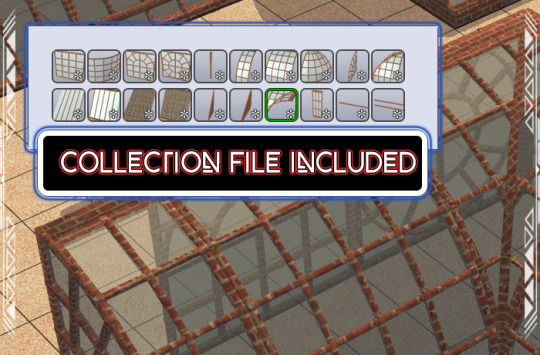

BUILDING TIPS If you want them to function like walls, combine them with invisible walls, fences, windows, etc. You may need to use the grid on/off cheat to move pieces slightly outside of a four-walled room. Otherwise, the game will consider the object “inside” the room and it will go dark. Fencing is recommended when placing floor tiles directly above the pieces to reduce flickering. Also, you can fill gaps with Roof Niche 001/002, Wall Deco 001/002, and the Corner Niche.

CREDITS Thanks: Simming and Sketchfab Communities. Sources: Beyno (Korn via BBFonts), EA/Maxis, Industrial Set – Steel & Glass (Feivelyn, 2020 via CCA-Non-Commercial). Nook & Niches (BuggyBooz, 2012), Offuturistic Infographic (Freepik).
433 notes
·
View notes
Text
THE COMPLETE GREEN ARROW BY DENNIS O'NEIL - READING GUIDE
On The Order:
Reading this chronologically woudn't really work. He retconned his own work(for the better). However, there are notes here that would allow you to easily organize things chronologically.
There are some stories here that don't really have Green Arrow that much. You will know which ones as there will be notes on them pointing that out.
The Retconned Story and The Retcon Story:
To read chronologically without facing contradictions, just skip JLA #75 and DC Super-Stars #17, And instead read Peacemakers and The Arrow and the Bat before JLA #66.
PRE-CRISIS
DENNIS O'NEIL'S RUN ON JUSTICE LEAGUE OF AMERICA






This is the run in which everything starts. Anarchist Green Arrow, Black Canary in the League, GA and BC relationship...
He doesn't show up in 3 issues of the run(70, 73-74).
This run is also very important for Black Canary. And their relationship. This is where everything starts. Black Canary on the JLA, anarchist Green Arrow. BC and GA's relationship...
Justice League of America #66, 68-75, 77-83
GA doesn't show up in 3 issues: #70, 73-74
The latter part of this run was released during the beginning of GL/GA
PRE-CRISIS ORDER:
The order here is the DCUGuide order.
JLA #66, 68-75, 77-80
Green Lantern #76-77
JLA #81
Green Lantern #78-79
JLA #82-83
Green Lantern #80-83
Superman #236(b)
Here my bias showing. It's a short story about Krypton. GA and BC are listening to Superman telling this story. I really like this one. It's worth checking out. You get cool moments for GA and BC in the first and last page of this.
Green Lantern #84-86, 89
The Flash #217-219(b stories)
Green Lantern #90-99
DC Super-Stars #17(a)
Origin story in a flashback. The non-flashback part is following up on JLA #75
Green Lantern #102-106, 108-115
World's Finest Comics #256(b)
Team-up with Black Lighting, part of O'Neil's run on BL
Green Lantern #116-122
DC Comics Presents #20
POST-CRISIS



FROM THE QUESTION BY DENNIS O'NEIL
These stories are from O'Neil's Question run.
The Question #17-18
FABLES



Detective Comics Annual #1
Green Arrow Annual #1
The Question Annual #1
LOSING/SAVING FACE
The Question Annual #2
Green Arrow Annual #2
Green Arrow Annual #3
Epilogue of The Question's 1986 series.
THE RING, THE ARROW AND THE BAT
All stories from now on are team-ups with either Batman or Green Lantern.
Batman/Green Arrow: The Poison Tomorrow
Justice League Task Force #5-6
Part of Knightquest: The Search
Not that much Green Arrow
PEACEMAKERS



Legends of the DC Universe #7-9
This is a tale of how GA came to be the character O'Neil made him be. It retcons JLA #75
O'Neil characterize this as a Year One-type story
It works with the post-zero hour continuity. Just doesn't match certain elements of O'Neil's JLA run
It leads to GL/GA
It matches fine with GL/GA
Due to Ollie's characterization, this would have happened before JLA #66
THE ARROW AND THE BAT
Batman: Legends of the Dark Knight #127-131
Sequel of Peacemakers
It's set before the last scene of Peacemakers.
DC Retroactive: Green Lantern - The '70s
This one ties Peacemakers and The Longbow Hunters.
It would fit right after the next story.
TIME ALONE
Green Lantern 80th Anniversary Super Spectacular(d)
Last published O'Neil work.
I don't know where this would fit. I would guess before Green Lantern #172. For Green Arrow, that would be after DC Comics Presents #20
#DC#Green Arrow#DC Comics#Reading order#Reading Guide#Ollie#Oliver Queen#Dennis O'Neil#Green Lantern#Copper Age#Neal Adams#Plastic Age
71 notes
·
View notes
Text
NBCUniversal has finalized its defamation settlement with a Georgia doctor who was repeatedly called a "uterus collector" by MSNBC.
NBCUniversal, the parent company of NBC News and MSNBC (the latter is currently being spun off as a separate company), settled the $30 million lawsuit filed by Georgia gynecologist Dr. Mahendra Amin. Amin who was the subject of a report claiming he performed unnecessary hysterectomies at an Immigration and Customs Enforcement (ICE) center.
Both parties struck the settlement in February, but the lawsuit was officially dismissed Friday in the U.S. District Court for the Southern District of Georgia. The terms of the settlement were not publicly disclosed.
"We are pleased that Dr. Amin is able to move on from his years-long litigation against NBCUniversal," Amin's attorneys, Stacey Evans and Scott Grubman, told Fox News Digital. "It is unfortunate that he had to sue to get confirmation of what was known all along—that he did not perform mass hysterectomies on women detained at Irwin County Detention Center. We are glad that the judge found those statements false as a matter of law because, in fact, Dr. Amin performed only two hysterectomies, both of which were medically necessary and consented to by the patients."
"Dr. Amin is a dedicated physician who has dedicated his entire career to serving underserved communities. The recklessness of NBCUniversal to try to paint him as an evil doctor was disgusting and we are glad they finally settled the case," they added.
READ ON THE FOX NEWS APP
Representatives from NBCUniversal and MSNBC did not immediately respond to Fox News Digital's request for comment.
Amin was the subject of an NBC News article in September 2020, which cited a whistleblower's claim that he was performing unneeded hysterectomies while providing medical care to women detained at the Irwin County Detention Center.
MSNBC quickly followed with a series of on-air reports on "Deadline: White House," "All In with Chris Hayes" and "The Rachel Maddow Show," all running with the "uterus collector" label for Amin.
Amin filed a lawsuit against parent company NBCUniversal, alleging he was falsely portrayed as "an abusive, unethical, and dishonest physician who treated and operated on immigrant women in an abusive fashion, without consent, and motivated by profit instead of quality healthcare."
Judge Lisa Godbey Wood of the Southern District of Georgia previously ruled that a jury could reasonably find actual malice and the trial was set to begin April 22, in Waycross, Georgia. In light of the settlement agreement, the court canceled the scheduled trial.
"NBC investigated the whistleblower letter's accusations; that investigation did not corroborate the accusations and even undermined some; NBC republished the letter's accusations anyway," Judge Wood wrote last year in a 108-page summary.
Amin believed "false and defamatory" statements published with actual malice that caused him significant damage were said six times on "Deadline: White House," seven times on "All in with Chris Hayes" and 10 times on "The Rachel Maddow Show."
MSNBC hosts Rachel Maddow, Chris Hayes and Nicolle Wallace were among potential witnesses if it reached trial, along with NBC News reporters Jacob Soboroff and Julia Ainsley, MSNBC producer Denis Horgan, senior director of stands and practices Mary Lockhart, deputy head of standards Chris Scholl and others.
Judge Wood previously ruled that multiple statements were proven false, noting "undisputed evidence has established" that "there were no mass hysterectomies or high numbers of hysterectomies at the facility," "Dr. Amin performed only two hysterectomies on female detainees from the ICDC," and the doctor is not a "uterus collector.
30 notes
·
View notes
Photo
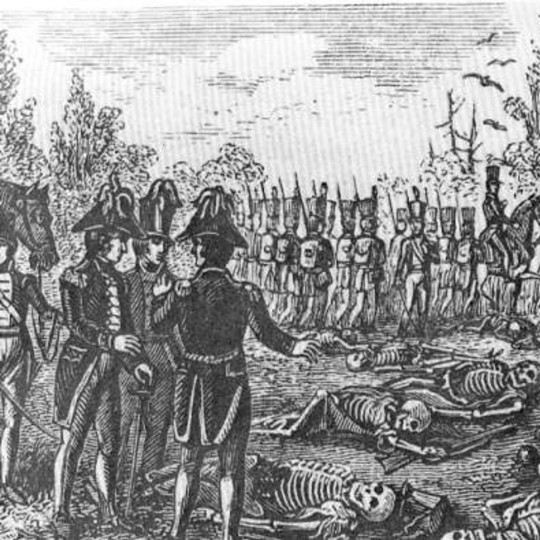
J. R. Giddings' Account of the Dade Massacre of the Second Seminole War
The Dade Massacre (also given as the Dade Battle, 28 December 1835) was the opening engagement of the Second Seminole War (1835-1842) between Euro-American forces and those of the Seminole, Black Seminole, and runaway slaves who had found freedom among the Native Americans of Florida. Of the 110 men of Dade's command, 108 were killed.
Dade Massacre Site Illustration
Unknown Artist (Public Domain)
Major Francis L. Dade (l. 1792-1835) was ordered by General Duncan Lamont Clinch (l. 1787-1849) to march his men from Fort Brooke to reinforce the garrison at Fort King and chose a slave named Louis Pacheco, owned by one Antonio Pacheco of a nearby plantation, as his guide. Louis, who secretly had close ties to the Exiles (runaway slaves from the Carolinas, Georgia, and other slave-holding states), Black Seminoles, and Seminoles, alerted them to the route Dade would take to Fort King and suggested the perfect place for an ambush.
Louis' plan worked as envisioned and almost the entire command, including Dade, was killed in the attack. The casualties for the Seminole alliance were three killed and five wounded. The Dade Massacre and the ensuing Second Seminole War were a direct result of the Indian Removal Act of 1830 and the common practice of slave-hunters from the United States kidnapping former slaves, Black Seminoles, and freedmen for enslavement on US plantations.
There was no formal victory declared at the end of the Second Seminole War, and no treaties were signed. Many of the Seminole, Black Seminole, and former slaves were able to negotiate relocation to Indian Territory (modern-day Oklahoma), while others were forcibly removed, and still others never surrendered and remained in Florida.
One of the most detailed accounts of the Dade Massacre comes from the famous abolitionist Joshua Reed Giddings (l. 1795-1864) of the US House of Representatives in his book The Exiles of Florida: or, The Crimes Committed by Our Government against the Maroons, who Fled from South Carolina and other Slave States, Seeking Protection under Spanish Laws, published in 1858. Giddings' account is based on an earlier history of Florida, which drew on interviews with members of the Seminole forces that ambushed Dade in December 1835.
Joshua Reed Giddings
Matthew Brady (Public Domain)
Spanish Florida, Tensions, & Second Seminole War
The region that became Florida was claimed by the Spanish after Juan Ponce de León landed there in April 1513. Between 1539 and 1559, Spanish settlements developed, displacing the indigenous peoples who included the Creek and the Pensacola nations, but trade was established, and Spaniards married Native Americans of various nations, and, in time, also former slaves who had escaped from bondage in the Thirteen Colonies.
In 1738, Fort Mose, near St. Augustine, was established and garrisoned by escaped slaves who were granted freedom and citizenship in exchange for their defense of the region against encroachments by the British colonists to the north. Fort Mose became the first legally recognized free Black settlement in North America.
Spain encouraged slaves in the Thirteen Colonies to flee to Florida, and many did so, along with an influx of Chickasaw, Choctaw, Muscogee Creek, and Yamasee citizens, some of whom broke off from the larger Creek bands to settle on their own, and these became known as the Seminole, whose name may be derived from the Creek for "runaway" or "outcast." Some Seminole intermarried with former slaves and established their own communities of Black Seminoles. These various groups lived and traded with each other until Spain lost Florida to the British in 1763 after the French and Indian War (1754-1763). The British then established themselves in the region and encouraged their citizens to settle there.
A Seminole Woman
George Catlin (Public Domain)
The Seminole sided with the British during the American Revolutionary War (1775-1783) and, afterwards, Spain was able to retake Florida, and it became a haven for runaway slaves and Native Americans fleeing Euro-American persecution. General Andrew Jackson led troops into Florida to break up these enclaves of African Americans and Native Americans in the First Seminole War (1816-1819). After Jackson became President of the United States, he issued the Indian Removal Act of 1830 to forcibly relocate the Seminole (as well as many other Native peoples of North America) to Indian Territory west of the Mississippi River. Pressure on the Seminole to comply with this led to the Second Seminole War, which also encouraged one of the largest slave uprisings in US history as the Seminole resistance inspired slaves on plantations in the Carolinas and Georgia to fire the fields and flee to Florida.
The event that set the Second Seminole War in motion (though not the cause of the conflict) was the Dade Massacre of 1835. To the Seminole, Black Seminole, and free Blacks of Florida, the Dade Massacre was a great victory, and leaders like Chief Osceola of the Seminole (l. 1804-1838) and John Horse of the Black Seminole (also known as Jean Caballao, l. c. 1812-1882) looked forward to many more. To the US authorities, however, the Dade Massacre was simply proof that the Native Americans had to be removed from Florida along with any of their allies. Osceola died in captivity in 1838, but John Horse was able to lead his people to Oklahoma and then, when US authorities refused to honor their agreement, on to Mexico.
Major Francis Dade's Death
Jesse Olney (Public Domain)
Continue reading...
30 notes
·
View notes
Text
HOW FAR BACK IN TIME CAN WE SEE me cryIN SPACE??
Blog#469
Wednesday, January 8th, 2025.
Welcome back,
The Hubble and James Webb Space Telescopes have observed the most distant star ever seen – Earendel – whose name means morning star. Even though Earendel is 50 times the mass of our sun, and millions of times brighter, we would not normally be able to see it. We can only see it due to an alignment of the star with a large galaxy cluster in front of it whose gravity bends the light from the star to make it brighter and more focused. The galaxy cluster essentially acts as a lens.

Astronomers see into the deep past when we view distant objects. Light travels at a constant speed (3×108 meters per second). So, the farther away an object is, the longer it takes for the light to reach us. By the time the light reaches us from very distant stars, the light we are looking at can be billions of years old. Thus, we are looking at events that happened in the past.

When we observe Earendel’s light, we are looking at light the star emitted 12.9 billion years ago. We call this the lookback time. That’s just 900 million years after the Big Bang. But because the universe has also expanded rapidly in the time it took this light to reach us, Earendel is now 28 billion light-years away from us.
Hubble’s successor, the James Webb Space Telescope, may be able to detect even earlier stars. However, they would have to be nicely aligned to form a gravitational lens so that we can see them.

One of the main goals of Webb is to know what the early universe looked like and when early stars and galaxies formed, thought to be between 100 million and 250 million years after the Big Bang. And, luckily, we can get hints about this by looking even farther back than Hubble or Webb can manage.
We can see light from 13.8 billion years ago, although it is not starlight, because there were no stars then. The farthest light we can see is the cosmic microwave background. The cosmic microwave background is the light left over from the Big Bang, forming at just 380,000 years after our cosmic birth.

The universe before the cosmic microwave background formed contained charged particles of positive protons (which now make up the atomic nucleus along with neutrons) and negative electrons … and light. The charged particles scattered the light, which made the universe a foggy soup. As the universe expanded, it cooled until eventually the electrons combined with the protons to form atoms.

Unlike the soup of particles, the atoms had no charge, so the light didn’t scatter and could move through the universe in a straight line. This light has continued to travel across the universe until it reaches us today. The wavelength of the light got longer as the universe expanded … and we currently see it as microwaves. This light is the cosmic microwave background. We can see it uniformly at all points in the sky. The cosmic microwave background is everywhere in the universe.
Originally published on https://earthsky.org
COMING UP!!
(Saturday, January 11th, 2025)
"IS SPACE DARK OR BRIGHT??"
#astronomy#outer space#alternate universe#astrophysics#universe#spacecraft#white universe#space#parallel universe#astrophotography
41 notes
·
View notes
Text
It's December 4, 2024.
Today, the Supreme Court heard oral arguments in United States v. Skrmetti, a challenge to Tennessee's ban on gender-affirming care. The specific question presented is whether Tennessee's ban violates the Equal Protection Clause.
The challenge is to Tenn. Code Ann. § 68-33-103(a)(1). That is, it's a challenge to a bit of Tennessee's Annotated Code. Title 68, Chapter 33, "Prohibited Medical Procedures for Minors."
I don't have anything to say about Tennessee's ban on gender-affirming care. Nor do I have anything to say about how the Court will treat the case. Not yet, anyways.
But I have something to say about the Code.
I.
Tennessee's laws are compiled by its code commission.
Under state law, the commission is a five-member body, consisting of the state's chief justice, attorney general, and counsel for the legislature, along with another two members appointed by the chief justice. Tenn. Code Ann. § 1-1-101(a).
The code commission supervises the official publication of the state's statutes, codes and session laws. § 1-1-105(a). The commission is empowered to commission to contract with publishers to that end, § 1-1-106(a), and obliged to inspect and certify their work. § 1-1-110(a).
When its work finished, the commission puts its certificate of approval in each volume and pocket supplement. § 1-1-110(c). But their first certificate, the one they leave with the secretary of state, § 1-1-110(b), is what gives the code the force of law. § 1-1-111(a).
Beyond that, the commission's work is ministerial. It cuts and pastes. "[T]he commission shall not alter the sense, meaning or effect of any act of the general assembly, but shall copy the exact language of the text of the statutes, codes and session laws." § 1-1-108.
The commission may "rearrange, regroup and renumber" the laws; change their "section headings"; "correct manifest misspelling[s] and typographical errors"; and "omit enacting clauses, repealing clauses, severability clauses, conditional clauses, preambles, [and] captions", § 1-1-108—and not much more.
II.
Tennessee leaves the work to Lexis, a private publisher.
Lexis's product, the Tennessee Code Annotated, is not eligible for copyright. Public.Resource.Org v. Matthew Bender & Co., No. M2022-01260-COA-R3-CV, slip op. (Tenn. Ct. App. Nov. 9, 2023). But it is not subject to compulsory disclosure, either.
Under current law, according to the state's intermediate appellate court, the Tennessee Code Annotated in the hands of Lexis is in the hands of a private contractor, not the State.
If Lexis had been the functional equivalent of a government entity, contracted to "perform a governmental or public function," it would be subject to the State's public records law. *8. But it's not.
That's what the state's intermediate appellate court says, at least. But its reasoning is less than persuasive.
III.
Lexis is merely a contractor. The commission specifies the work, and Lexis does the work. The commission may be exacting, but it isn't controlling. *9.
That's the court's argument, at least. But that strikes me as a less than complete account of the commission's duties under State law, which must inform any characterization of its contracts.
Under State law, the commission is "authorized and directed to" control each dimension of the compilation, Tenn. Code Ann. § 1-1-105(a), and must
supervise the execution of plans for the compilation, arrangement, classification, annotation, editing, indexing, printing, binding, publication, sale, distribution and the performance of all other acts necessary for the publication of an official compilation of the statutes, codes and session laws of the state of Tennessee
The commission's contractual powers, set out in the subsequent section, § 1-1-106, are an incident to its primary authority and duty to "formulate and supervise" the compilation. § 1-1-105(a).
The commission's primary authority and duty to prepare the compilation is plain on the face of the law. Under State law, the compilation is the commission's work, down to the copying and pasting, § 1-1-108(a):
In preparing the manuscript of the revised compilation (including pocket supplements and replacement volumes) for publication and distribution, the commission shall not alter the sense, meaning or effect of any act of the general assembly, but shall copy the exact language of the text . . .
This is more than the relationship suggested by the court. It's more than control over the product. It's control over production, the work of "preparing the manuscript."
To the extent that Lexis is doing the work, "preparing the manuscript," and "copy[ing] the exact language of the text," it is performing the commission's functions.
The court says "Lexis is not a stand-in for government." But that's exactly what it is. The commission is a government body. And Lexis is doing the commission's work.
That seems like a governmental function to me.
40 notes
·
View notes
Text
Version differences between the 18+/19+/Mature/Full/Complete release and 15+/16+/Older Teen/Another Version release of the ENNEAD manhwa
This leads to some confusion among many folks, so I figure a breakdown might be useful to more people. In simple terms, there are two versions of ENNEAD, the boys love manhwa: the 18+/19+/Mature/Full/Complete release (the name depends on the publisher), and a 15+/16+/Older Teen/Another Version release (the name depends on the publisher). This is true for a lot of BL comics, to a degree, but ENNEAD has more differences than usual.
This is also primarily to combat the narrative of people trying to sell the 15+/16+/Older Teen/Another Version release as some wholly different beast than the 18+/19+/Mature/Full/Complete release. Changes between the releases cover <8.9% of the whole story. The 15+/16+/Older Teen/Another Version release is, to some degree, slightly softer than the 18+/19+/Mature/Full/Complete release (mostly in the sense that there's visually less of it on the page). But it is still dark fantasy, covers the same topics, and deals with the same narratives. Showing less of a scene does not equal not having the scene happen at all.
This will be spoilery for things up through Season 2, Episode 126.
ENNEAD is unique in some ways in that Mojito works around the usual censoring so she doesn't have to have as much cropping and panel cutting or use lightsabers or those weird censor lines that other releases put over dicks. She makes use of specific posing, gestures, and clothing to indicate sensuality without showing bits constantly. The idea is, if she has to remake the scene for the 15+ version, she has to do as little work as possible while avoiding having the work be butchered to meet the censor requirements when it's redone for the 15+ release, and so the 15+ version can be as close to the Complete release as possible. There's still some cropping, but it's not as bad as it might be. Mostly, changes are just having characters be fully clothed or do different things together in the 15+ release.
ENNEAD does not use lightsabers or censor bars (with the caveat that, for some reason, the English translation on Tappytoon used lightsabers solely for the Mature release of S2E108; lightsabers are not present on the 19+/Complete Korean version). Mojito either redraws or replaces the panels, crops, adds clothing, and/or rewrites for the 15+ release.
ENNEAD is a serial webcomic, and is broken up into episodes (as of writing, 201 episodes in the 18+/19+/Mature/Full/Complete release, as that's one episode longer). This is a list of episodes with version differences:
Season 1: Episodes 28-32, 42-44, 74-75 (75 doesn't exist in the censored release)
Season 2: Episodes 19, 45-47, 71, 107, 108, 126
Not all episodes are completely different throughout the episode. Some only have a few tweaks. Season 1, Episode 28, for example, just removes some bloodstains in the 15+ release. It doesn't otherwise change any of the panels. And even episodes with complete panel redraws aren't redrawn throughout the whole episode for the most part. That's 18/191 episodes, making up <8.9% of the whole story that are changed. The percentage is even smaller than that because most episodes with changes only change a few panels. The most extensive changes are in S1E30-32, 42-43, 74-75, and S2E45-47, 71, 107, 108, and 126.
A more detailed breakdown of the changes made for the 15+/16+/Older Teen/Another Version release in the digital and physical English releases:
S1E28/Volume 3, Chapter 7: Bloodstains removed [This was not kept for the English physical release for some reason; the bloodstains are in both releases, which is possibly an error, or just different country requirements]
S1E29-31/Volume 3, Chapter 8: Panel redraws and rewrites to soften the nsfw
S1E32/Volume 3, Chapter 8: Panel redraws and rewrites to soften the nsfw, added Seth POV focusing on his psyche
S1E42/Volume 4, Chapter 11: Panel redraws and rewrites to soften the nsfw
S1E43/Volume 4, Chapter 11: Extended Isis POV section with new panels and writing, shrunken Osiseth section. This is possibly the most extensively changed episode, as the uncensored version is mostly Osiseth, while the censored version is mostly Isis' POV.
S1E44/Volume 4, Chapter 11: Redrawn panels, mostly to remove more of the Osiseth, rewriting
S1E74/Volume 6 (presumed): There is an end AU story for each version of the season. The uncensored version contains an early draft of the manhwa where the new King Horus takes Seth as his prisoner. It is two episodes long. The censored version contains a story where Seth's punishment for losing the trial is to become tiny and held as Horus' captive. It's one episode long.
No version of season 2 has gone to print in any language as of yet. However, current physical volumes average 13 episodes a volume.
S2E19: Panel redraws and rewrites to soften the nsfw
S2E45: Panel redraws and rewrites to soften the nsfw
S2E46: Panel redraws and rewrites, including more information on Seth's attempted rescue of the boy
S2E47: Panel redraws and rewrites to soften the nsfw
S2E71: Panel redraws and rewrites to soften the nsfw
S2E107-8: Panel redraws and rewrites to soften the nsfw
S2E126: Panel redraws and rewrites to soften the nsfw
The sex scenes are all still in there, they're just shorter (and generally they're sort of alternate sex scenes). The non-con is also still there. It's just not as heavily emphasized.
For folks looking to buy the physical English release and wondering which version to get as Seven Seas offers both, volumes 1, 2, and 5 have no differences. Volumes 3, 4, and possibly 6 should have differences. 3 and 4 definitely do, but we don't know what's in volume 6, yet. The listing on storefronts shows the paperback and hardcovers have different page counts, which might be different to include the AUs. The English physical Seven Seas release is nearly identical to what's on Tappytoon in English and the digital Korean releases.
If you'd like to know where to read it, you can read both the Mature and 16+ releases in English on Tappytoon on both the browser and app versions of the site. More information on the manhwa here.
32 notes
·
View notes
Text
Gene Has BPD, And Here's Why
At least, to me he does. But that doesn't make for as catchy of a post title.
To be clear: I know this was not intentional on Knowles’ part. Borderline Personality Disorder was not first diagnosed until 1980, and of course ASP was published in 1959.
However. Regardless of what kind of character Knowles set out to write, Gene Forrester really fits the diagnosis of BPD. So I’m giving it to him.
If you’re on the ASP discord server, you may have already seen me explain why I see Gene as having BPD, but I wanted to make a more formal, comprehensive post here on Tumblr because this reading of him really means a lot to me.
The DSM-5 lists 9 symptoms of Borderline Personality Disorder, 6 of which can be clearly seen in Gene. Page numbers cited are from where the passages are in my edition of ASP, they may slightly differ in other editions.
Frantic efforts to avoid real or imagined abandonment
Gene's insecurity, his belief that Finny is superior to him, creates an immense fear that Finny will leave him - he "[does not] know why Finny had chosen [him]" (p. 109), of all people, to be close friends and confidants with. His narration is marred with the belief that if Finny realizes that Gene is not better that him, that he wins even in an imaginary competition of Gene's only creation, he will leave, because why stay?
Of the Super Suicide Society of the Summer Session, he says "I hated it...But I always jumped. Otherwise I would have lost face with Phineas, and that was unthinkable." (p. 34)
His own thoughts, his own fears of everything else, become irrelevant in the face of what Finny wants for him. He is unwilling to do anything that might risk Finny unchoosing him, something he sees as inevitable if he were to be wholly himself.
"At that time it never would have occurred to me to say ‘I don’t feel like it tonight,’, which was the plain truth every night…acting against every instinct of my nature, I went without a thought of protest.” (p. 34)
“None of this mattered now; I would have listlessly agreed to anything.” (p. 59)
“But there was no mistaking the shield of remoteness in his face and voice…The war then passed away from me, and dreams of enlistment and escape and a clean start lost their meaning for me.” (p. 108)
A clean start, something Gene thinks might be better for him - it cannot happen so long as it might lead to that remoteness, that emotional and physical separation.
Unstable and intense interpersonal relationships alternating between idealization and devaluation
Gene has this one in spades.
A person with BPD's most intense relationship is called their favorite person - despite the name, this phenomenon is generally miserable for the person with BPD, if not both people involved - and the alternation in how one views their favorite person is called splitting. Phineas is Gene's favorite person - his greatest love, his greatest envy, his enemy if only in mind. And Gene splits on him a lot.
Obviously the intensity of their relationship, even beyond the unignorable homoerotic undertones, is...beyond the scope of what is normal, to say the least.
“He drew me increasingly away from the…crowd…into a world inhabited by just himself and me…just Phineas and me alone among all the people of the world” (p. 127)
Alongside Gene's perpetual desperation for Finny's approval is a view of his best friend that fluctuates wildly from near-religious devotion to unfettered hatred, often in short spans of time or even from one page to the very next.
“Finny had practically saved my life.” (pg. 32)
“I wouldn’t have been on that damn limb except for him.” (pg. 33)
“‘You’re too good to be true.’” (p. 44)
“He was no better than I was.” (p. 56)
“There was a swift chain of explosions in my brain, one certainty after another blasted—up like a detonation went the idea of any best friend, up went affection and partnership…you [Gene and Finny] are even in enmity…you did hate him…he hated you” (p. 53)
Markedly unstable sense of self
This one is very prominent as well. Gene’s relationship with Finny is incredibly codependent, and after Finny’s injury Gene increasingly begins to see himself as part of Finny rather than his own person. And it is a relief to him, because beyond Finny he has no idea who he is.
“I was Phineas, Phineas to the life…I had no idea why this gave me such intense relief, but it seemed, standing there in Finny’s triumphant shirt, that I would never stumble through the confusions of my own character again.” (p. 62)
“And I lost a part of myself to him then, and a soaring sense of freedom revealed that this must have been my purpose from the first: to become a part of Phineas.” (p. 85)
When Phineas dies, Gene "could not escape the feeling that this was [his] own funeral" (p. 194) - his sense of self is so inseparable from Finny that he, or at least a significant part of himself, dies with him.
In death, Gene remarks Finny had "taken [Gene's anger] with him" (p. 203) - and though this part of him is perceived as undesirable, as better off gone regardless, it is inarguably a part of Gene. Another part of him that is gone "forever" (p. 203).
Even as an adult, 15 years later, Gene has trouble defining exactly who he is. When considering how he has changed since he was last in Devon, all he can come up with is the following:
"Older...taller...I had more money and success and 'security'" (p. 11-12)
Objective, material, impersonal statements. He describes himself as one might describe someone they see from across the street.
Who actually is Phineas? is a question very much worth asking of the book, considering Gene's notoriously unreliable narration. But one could also ask Who is Gene? and come up with just as uncertain of an answer, even though we spend the entirety of the novel seeing the world through his voice.
Self-damaging impulsivity, such as substance abuse
Gene's indulgence in Finny's desires often involves Gene knowing that something has the potential to harm him, whether physically or otherwise, and yet doing it regardless. For the intellectual, 'reasonable' counterpart of the main duo, one would expect more pushback even if only in Gene's own mind. Yet he doesn't resist - he simply does.
“With the sensation that I was throwing my life away, I jumped into space.” (p. 17)
“Going there risked expulsion, destroyed the studying I was going to do for an important test the next morning, blasted the reasonable amount of order I wanted to maintain in my life…’All right,’ I said.” (p. 46)
Even without Finny, Gene describes himself as prone to unnecessarily risky things.
“But I was used to finding something deadly in things that attracted me; there was always something deadly lurking in anything I wanted, anything I loved. And if it wasn’t there…then I put it there myself.” (p. 101)
Finny also describes Gene as "smok[ing] like a forest fire" (p. 127) - in the 1940s smoking was extremely widespread and normalized, but apparently Gene engages in substance use to an extent that was considered excessive even then.
Affective instability; intense episodes lasting hours to days
Even beyond his…turbulent relationship with Finny, Gene displays extreme changes in mood.
“I felt the unhinged, uncontrollable joy…which had broken out sometimes during those days [at Devon]” (p. 10)
“I wanted to break out crying from stabs of hopeless joy, or intolerable promise…because I knew of too much hate to be contained in a world like this.” (p. 55)
This is best demonstrated by the first portion of his strange episode after Finny's second leg injury, during which he finds himself both laughing hysterically over bizarre, imagined situations and crying. His thoughts are stilted, words and phrases repeating.
"That was pretty funny. I’ll bet I could get a rise out of Finny with— Dr. Stanpole was fairly gabby too. What was he always saying. Nothing. Nothing? Well there must be something he was always saying." (p. 182-183)
"Did Finny like Phil Latham? Yes, of course he did. But wouldn’t it be funny if he suddenly turned to him and said, 'Phil Latham, you’re a boob.' That would be funny in a way. And what about if he said, 'Dr. Stanpole, old pal, you’re the most long-winded licensed medical man alive.' And it would be even funnier if he interrupted that night nurse and said, 'Miss Windbag, you’re rotten, rotten to the core. I just thought I ought to tell you.'" (p. 183)
“I couldn’t stop myself from laughing…I was laughing so hard it hurt my stomach…and then I noticed that there were tears all over my hand.” (p. 183)
Transient paranoid ideation or dissociation
Part of Gene’s devaluation stage with Finny is paranoia around the idea that Finny is trying to ‘ruin’ him in some way.
Finny merely studying for an exam becomes, to Gene, “his emergency measures to save himself” (p. 55) from failure in the competition that exists only in Gene’s own head.
When Finny tells Gene he was going to reach out for him as he fell, Gene’s immediate assumption is that it was to “‘drag me down too’’ (p. 65), rather than to simply stabilize himself so he wouldn’t crash to the ground.
The second part of Gene's breakdown, after his first visit to Phineas, also shows his dissociation, feeling as if he is completely disconnected from the world, which is itself dreamlike and unstable.
"I was trying to cope with something that might be called double vision. I saw the gym in the glow of a couple of outside lights near it and I knew of course that it was the Devon gym which I entered every day. It was and it wasn’t. There was something innately strange about it, as though there had always been an inner core to the gym which I had never perceived before, quite different from its generally accepted appearance. It seemed to alter moment by moment before my eyes, becoming for brief flashes a totally unknown building with a significance much deeper and far more real than any I had noticed before." (p. 185-186)
“They rolled away impervious to me as if I were a roaming ghost…I alone was a dream, a figment which had never really touched anything. I felt that I was not, never had been and never would be part of this overpoweringly solid and deeply meaningful world around me.” (p. 186)
"But I could not hear, and that was because I did not exist." (p. 187)
The other 3 symptoms
Gene does display a bit of the other symptoms listed in the DSM-5 as well, though to a much more minor extent. The real-life, not-fictional-character diagnosis of BPD only requires 5 of the 9 symptoms to be present regardless, so I think what I’ve shown above is sufficient.
Suicidal behavior, gestures, or threats
While Gene never attempts suicide or outright expresses that he might do so, I at least think it's worth noting that:
A. He helped name the Super Suicide Society
B. He had no objections to the club he helped found, and would presumably be somewhat be a 'representative' of, being called such a thing
Inappropriate, intense anger or difficulty controlling anger
While Gene isn't an especially angry person, he does have a notable instance of violence when he gets into a fight with Quackenbush. The moment he hears an insult that would apply to Finny, he hits Quackenbush before he has the chance to think about it or even consciously acknowledge that he was offended on Finny's behalf rather than his own.
Chronic feelings of emptiness
I didn't find anything for this one. I may have simply missed something, though, so if there are moments you think would fit this, I would love to hear your thoughts! Clearly, this is a topic I'm very invested in.
Conclusion
The purpose of this post was to spread my most deeply-held headcanon like a virus. I hope it has infected you. Bye-bye!
#a separate peace#gene forrester#asp quotes/analysis#gene bpd headcanon#asp gene#asp#john knowles#ok now back to shitposting
11 notes
·
View notes
Text
Batman #108 (2021) Sun Khamunaki Exclusive Variant Edition, Jorge Jiménez & Ricardo Lopez Ortiz Pencils, James Tynion IV Story, Miracle Molly (First Full Appearance)
#Batman #108 (2021) #SunKhamunakiExclusive Variant Edition, #JorgeJiménez & #RicardoLopezOrtiz Pencils, #JamesTynionIV Story, #MiracleMolly (First Full Appearance) Batman goes undercover to infiltrate the transhumanist gang known as the Unsanity Collective and learn more about their sudden appearance in Gotham. https://www.rarecomicbooks.fashionablewebs.com/Batman%202016.html#108S @rarecomicbooks Website Link In Bio Page If Applicable. SAVE ON SHIPPING COST - NOW AVAILABLE FOR LOCAL PICK UP IN DELTONA, FLORIDA #KeyComicBooks #DCComics #DCU #DCUniverse #KeyIssue


#Batman #108 (2021) #SunKhamunakiExclusive Variant Edition, #JorgeJiménez & #RicardoLopezOrtiz Pencils, #JamesTynionIV Story, #MiracleMolly (First Full Appearance) Batman goes undercover to infiltrate the transhumanist gang known as the Unsanity Collective and learn more about their sudden appearance in Gotham. https://www.rarecomicbooks.fashionablewebs.com/Batman%202016.html#108S @rarecomicbooks Website Link In Bio Page If Applicable. SAVE ON SHIPPING COST - NOW AVAILABLE FOR LOCAL PICK UP IN DELTONA, FLORIDA #KeyComicBooks #DCComics #DCU #DCUniverse #KeyIssue
#Batman#108 (2021) Sun Khamunaki Exclusive Variant Edition#Jorge Jiménez & Ricardo Lopez Ortiz Pencils#James Tynion IV Story#Miracle Molly (First Full Appearance)#Rare Comic Books#Key Comic Books#DC Comics#DCU#DC#Marvel Comics#MCU#Marvel#Marvel Universe#DC Universe#Dynamite Entertainment#Dark Horse Comic Books#Boom#IDW Publishing#Image Comics#Now Comics
1 note
·
View note
Text
Shimmer Eyes
https://archiveofourown.org/works/65098093/chapters/167410690
Summary:
Being a father was already hard enough, but when Powder suddenly comes down with a strange, unexplainable illness, Vander finds himself more worried than ever. His fear for his daughter only becomes worse when Sevika insists she recognizes the purple glow of his youngest's eyes, and brings her straight to the one man who could truly strike fear into him.
(I.E. Several people have time-traveled, with various side effects. Vander is not one of those people, but like hell he's leaving his daughter alone with Silco, no matter how strangely soft the man is acting.)
Full list of tags and info beneath the cut.
Rating:
Teen And Up Audiences
Archive Warning:
No Archive Warnings Apply
Fandom:
Arcane: League of Legends (Cartoon 2021)
Relationships:
Jinx & Vander (League of Legends)
Silco (Arcane: League of Legends) & Vander (League of Legends)
Jinx (League of Legends) & Silco (Arcane: League of Legends)
Sevika & Silco (Arcane: League of Legends)
Jinx (League of Legends) & Sevika (Arcane: League of Legends)
Silco (Arcane: League of Legends)/Vander (League of Legends)
Claggor (Arcane) & Jinx (League of Legends) & Mylo (Arcane) & Vander & Vi (League of Legends)
Ekko & Jinx (League of Legends)
Characters:
Vander (League of Legends)
Jinx (League of Legends)
Sevika (Arcane: League of Legends)
Silco (Arcane: League of Legends)
Benzo (Arcane: League of Legends)
Vi (League of Legends)
Mylo (Arcane: League of Legends)
Claggor (Arcane: League of Legends)
Ekko (League of Legends)
Additional Tags:
Time Travel
Time Travel Fix-It
POV Outsider
Father-Daughter Relationship
Protective Sevika (Arcane: League of Legends)
Soft Sevika (Arcane: League of Legends)
Protective Silco (Arcane: League of Legends)
Soft Silco (Arcane: League of Legends)
Parent Silco (Arcane: League of Legends)
Silco Needs a Hug (Arcane: League of Legends)
Protective Vander (League of Legends)
Good Parent Vander (League of Legends)
Jinx Needs a Hug (League of Legends)
Jinx is a Little Shit (League of Legends)
Jinx Needs Therapy (League of Legends)
Jinx Has Issues (League of Legends)
Shimmer (Arcane: League of Legends)
Medical Conditions
Confusion
Fear
Mental Health Issues
Mental Instability
Implied/Referenced Drug Use
Implied/Referenced Character Death
Implied/Referenced Torture
Implied/Referenced Domestic Violence
Post-Traumatic Stress Disorder - PTSD
Trauma
Tags May Change
Complicated Relationships
Happy Ending
Angst with a Happy Ending
Hurt/Comfort
Sick Character
Fluff
Angst
Fluff and Angst
Blood and Injury
Minor Injuries
Self-Harm
Needles
Medical Inaccuracies
There Was Only One Bed
Kind Of
Sharing a Bed
Literal Sleeping Together
Mutual Pining
Sevika Does Not Get Paid Enough (Arcane: League of Legends)
Benzo and Silco have beef
Caring Ekko (League of Legends)
Protective Vi (League of Legends)
Good Sibling Vi (League of Legends)
Protective Jinx (League of Legends)
Canon-Typical Hallucinations
Language: English
Series: Part 1 of Time Travelers Are Real Anonymous (T.A.R.A)
Collections: Readers' 📚 Booknook📖(~‾▿‾)~
Stats:
Published: 2025-04-28
Updated: 2025-05-20
Words: 25,278
Chapters: 12/?
Comments: 365
Kudos: 500
Bookmarks: 108
Hits: 8,237
#fandom#fanfic#fanfiction#wip#arcane#time travel#time travel fix it#time travel shenanigans#zaundads#vander#silco#silco x vander#fanfic rec#fanfiction recommendation#arcane fic rec#complicated family drama#ao3#ao3 fanfic#archive of our own#dad silco#zaun dads#dad vander#co parenting
13 notes
·
View notes
Text
Natsume Yuujinchou chapters NOT yet adapted
Natsume Yuujinchou S7 ended airing on TV Dec 23, 2024.
12 episodes aired on TV (my post for S7 EP list cf to manga). Vol5 Blu-ray/DVD comes out Apr 14, 2025. Ep13 (OVA?) is listed being on this disc. OVA or? Original content (AO) or will use manga based material? Wait and see. . . In meantime (so far):
The manga chapters NOT yet used in the anime version:
Vol 8: Special 8
Vol 16: Special 14
Vol 18: 71
Vol 21: Special 17 ***Apr 26, 2025: Adapted as Ep13, on Vol5 DVD/Blu-ray only for S7
Vol 22: 85-86 (Special 19 used, 87-89 used S7)
Vol 23: 90-91 (92-94 used S7)
Vol 24: Special 20 (95-96, 99 used S7)
Vol 25: 100-102, Special 21, 22
Vol 26: 103-107
Vol 27: 109-111 (108 used S7)
Vol 28: 112-115
Vol 29: 116-119
Vol 30: 120-123
Vol 31: 124-127 (Sept 5, 2024 came out)
Vol 32: 128-134 (Came out Apr 4, 2025) ***Last page says Vol33 isn't out until 2026 oO
Published in 2025:
Special 23
Special 24 Chapter 135 (unless a special, will be out in Lala issue out May 23, 2025)
Chapter 136+
#natsume yuujinchou#natsume season 7#natsume's book of friends#nyanko sensei#natsume takashi#natsume yuujinchou shichi
23 notes
·
View notes
Text
OFB Props: Signs 001 Mix

Published: 7-14-2024 | Updated: N/A SUMMARY 100 posters, tags, and area signs to organize sale items on your commercial lots. Customize poster images, infographics, and barcodes/currency labels. Labels are color-coded in Simlish and English to make sorting objects easier: COOK (white label/for cookables, ingredients), DRINK (red label/ for edible beverages), EAT (pink label/for edible foods), GROW (green label/ for harvestables), HEAL (orange label/for functional medicines, motive boosters), CRAFT (brown label/for craftables, ingredients), STOCK (yellow label/for stockable foods, supplies), USE (blue label/for all other functional items), VIEW (gray label/for deco only items), and “other” (black and purple/barcode). These are general deco items, so you don’t have to sort by function/color unless you want to.
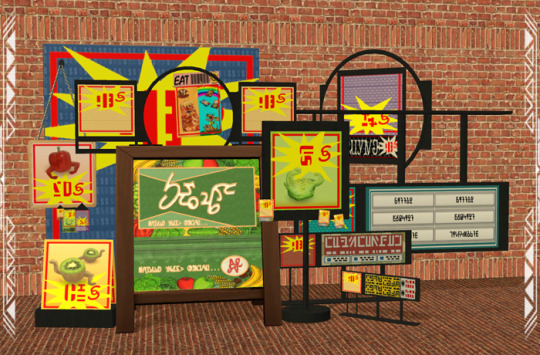
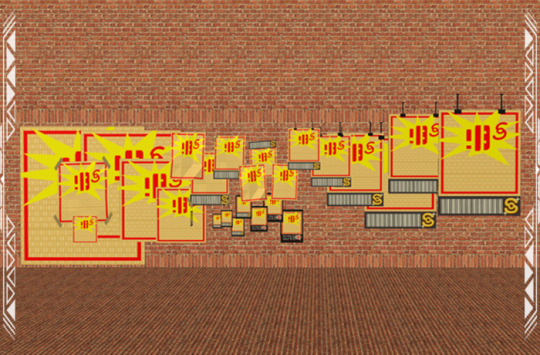
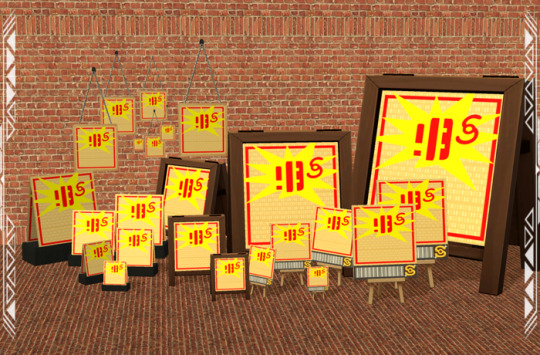
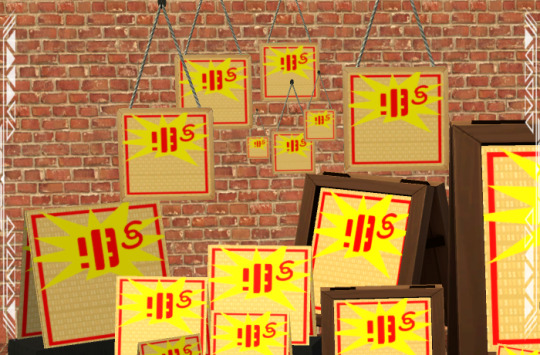


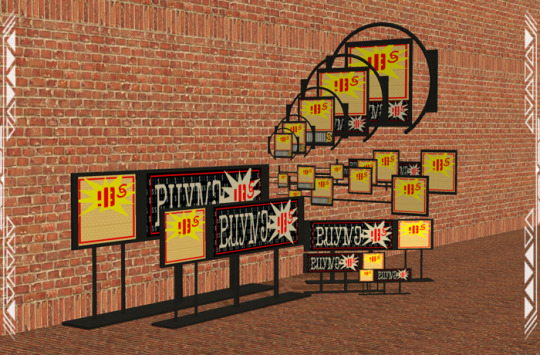

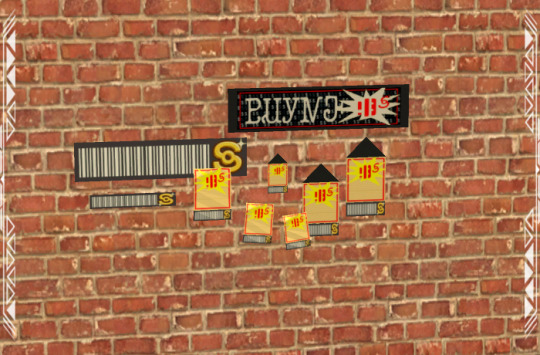
DETAILS Pets EP or higher. Cost: $3 | Environment: +1 | Buy > Deco > Wall Hangings/Sculptures (some signs don’t have to be placed on walls) You need my Poster Pack (Simmons, 2024) for all poster recolors. Sale Poster 7 (barcodes/currencies), and Ceiling Sign Info 4 (infographics) – are also REQUIRED. Recommended textures sizes for new recolors are 512x512 (poster graphics) and 512x128 (bar codes/currencies, infographics). Simlish text is ideal since images may be reversed on the back side of some objects, or slightly stretched. *Thumbnails for the BACK side of the posters may not generate accurately in the catalog (default game quirk). Make sure you can see the back side onscreen when recoloring. Finally, you’ll likely need “moveobjects on/off” and “snaptogrid on/off” cheats when placing some items.
ITEMS 11 ceiling signs (160-440 poly, poster images on signs 1-6 appear on back side). 11 standing signs (188-440 poly) 3 curved standing signs (548 poly) 10 wall signs (220-224 poly) 5 curved wall signs (874-876 poly) 3 curved/winged signs (1072 poly) 7 hanging signs (269 poly) 6 Instore Mini Billboards (4t2 conversion by NekoSayuri, 2018; EA; 116 poly) 5 Lil’ Business Chalkboards (4t2 conversion by itsnotdissimilar, 2016; EA; 128 poly) 7 framed posters (64 poly) 5 unframed posters (12 poly) 4 taped, unframed posters (108 poly) 3 unframed, wrinkled posters (18 poly) 3 wrinkled tags (34 poly) 3 smooth tags (155 poly, poster images appear reversed on back side) 3 info/barcode tags (4-60 poly) 6 easel signs (512 poly) 6 sales card on stands (card mesh by Cathee, 2008; 40 poly).
DOWNLOAD (choose one) from SFS | from MEGA *collection file included


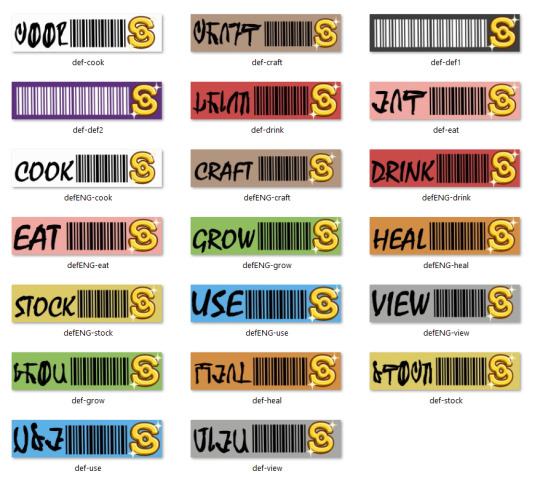




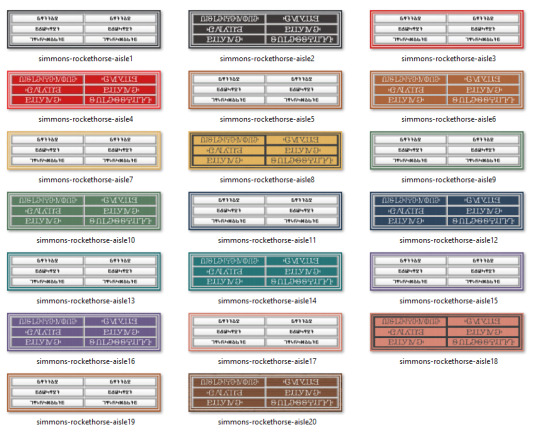
COMPATIBILITY I recommend using Shift Everything (Lamare, 2022) or Object Freedom 1.02 (Fway, 2023) to enable floor-to-ceiling shiftability for all objects. This will also minimize shadow issues when shifting the signs. Some signs show a small gap between the frame and poster when viewed at close range. CREDITS Thanks: Sim Crafters, ChocolateCitySim. Sources: Beyno (Korn via BBFonts), EA/Maxis, Offuturistic Infographic (Freepik), Fonts (Gazifu, 2013; Ajaysims), Sims 3 (EA, 2009; 2012), Sims 4 (EA, 2014; 2020), Sims Mobile (EA, 2018), Supermarket Aisle Signs (Rockethorse, 2014), Synapticsims, Vector_Corp.
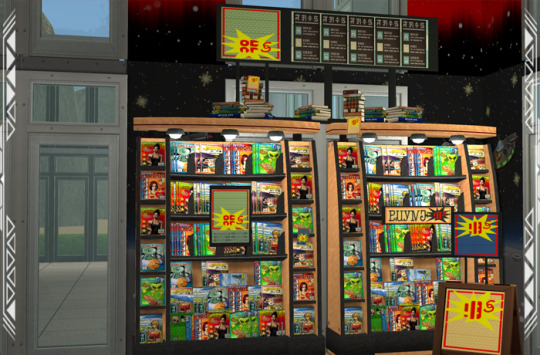
126 notes
·
View notes